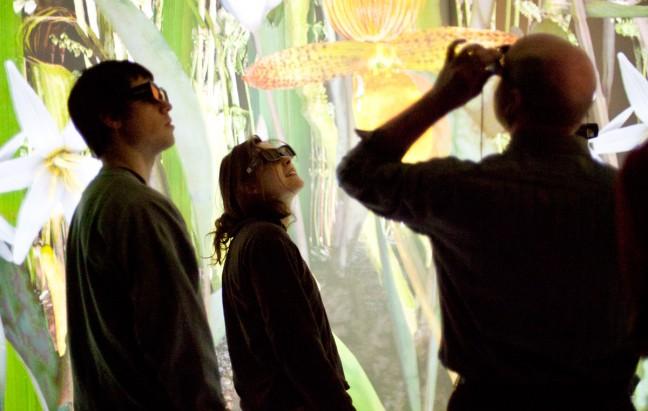In a world with increasing reliance on technology, the University of Wisconsin’s Virtual Environments Group has been utilizing virtual reality environments and 3D data analysis for both research and education to visualize scientific data in a whole new way.
Virtual reality, VR for short, is essentially a three-dimensional, computer-generated space that can be experienced and accessed with helmets, goggles, gloves and other equipment. It creates an immersive experience by allowing the user to interact with 3D worlds using all of their senses. Though artificial, virtual reality is much more hands-on, separating its use apart from a traditional display screen we are accustomed to viewing.
Based on the presumption that many home environments play a prominent role in how people manage their health and self-care, a group at the Wisconsin Institute for Discovery’s simulated these conditions using VR technology in their lab. By visualizing the interiors of people’s homes, researchers gained insight as to where key reminders or health-related devices should be located in order to allow people to optimize their ability to care for themselves.
These kinds of simulations are accomplished using CAVE, a six-sided room with projectors on all surfaces except on the plexiglass floor. Three-dimensional projections surround sound and microphones that allow for two-way communication are all built into the device. Similar equipment is also heavily used by research labs at the forefront of other emerging technologies.
The UW lab, which formerly took on the vizHOME project, has since molded into the university’s Virtual Environments Group to better focus their VR exploration efforts.
Most people associate VR with digital games and entertainment outlets, but some experts like Kevin Ponto, an assistant professor at the UW School of Human Ecology, feel much of VR’s potential remains largely untapped. He said augmented reality specifically, in which designers create inputs, is where we might see a lot more of these real-world applications in the future of technology.
There have even been rumors that Apple is in talks of releasing their own VR product. The technology would allow people to experience augmented reality in the form of lightweight eyewear, which could make this kind of technology more accessible for practical and conventional use.
“[Lightweight eyewear] is a gauge that you can start to embed our reality content in a world where it could theoretically be purely virtual, physical or some sort of mix,” Ponto said in an interview with The Badger Herald.
VR is not necessarily a new revelation, but its prospects are shaping out to be. Historically, it has been used in aerospace, automotive, oil industries and others. Even the military has used it for its own simulation purposes.
It turns out the same methodology used by the Virtual Environment Group can be applied to real life police investigations and crime scenes. Considering the costs, benefits and research of using VR technologies for police work, Ponto said two types of cases seem to benefit from the VR approach.
“The first is for car crashes, where you want to do the investigation as fast as possible because your goal is to try to clear out so traffic can keep moving, or for homicide cases, in which you want to capture every last detail because you never know what might be important later,” Ponto said.
This technology can also become a new way to engage with the input information and test hypotheses in a completely reimagined way. Jack Dong, a junior at UW, has worked a lot with scripting lab projects since joining Ponto’s team last semester.
Dong said having students experience VR technology first-hand can help normalize and excite people about its potential, though the in-person aspect has been difficult due to the COVID-19 pandemic.
Dong said he is proud of the work they have accomplished in his lab and is hopeful it can make a difference — big or small. The impacts of VR’s potential, however, may not all be positive.
“Every new technology has two sides,” Ponto said. “I think we are going to see things like VR addiction in the future.”
It is true that there may be side effects of indulging in a virtual realm, but researchers say awareness about this possibility is the first step of mitigation preparation. How researchers combat these potential issues — like motion sickness — will be up for debate as the technology develops.
“For many people, [VR] does produce motion sickness, feelings of dizziness and nausea. One of the reasons for motion sickness is a mismatch between users’ actual bodies and their virtual bodies,” Dong said. “Specifically, when playing games in VR, your eyes and ears tell you that you are making movement around the virtual world. But physically, no actual movements are generated. This can cause the brain to confuse.”
The Lab Report: Anantharaman Microbiome Lab digs into Lake Mendota’s bacteria
Regardless of these associated challenges, Ponto and the Virtual Environments Group have an optimistic perspective when it comes to the future of virtual reality and real-world applications, which is shared in passion and pursuit in many places beyond the UW campus.


